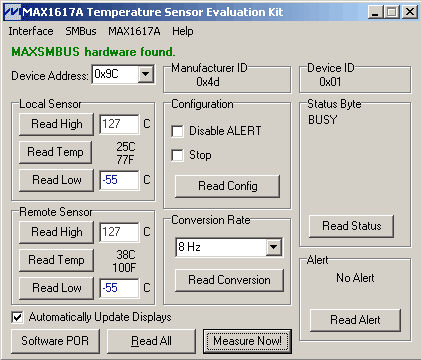How Good Are AMD's Bundled Coolers For The Athlon XP ?
Measuring Like AMD: Temperature Sensors Right On The Die
Since the last comparison test, THG has been using the same measurement platform preferred by AMD for its own cooler tests.
The testing platform consists of a modified A7V333 motherboard from Asus and a temperature-sensor evaluation kit from Maxim. The temperature-sensor evaluation kit reads the exact die temperature while the PC is running and displays it on the control computer. The modifications on the board allowed us to measure both processor voltage and current while the computer was running.
The testing platform allows you to measure thermal power and the die temperature precisely.
The temperature-evaluation sensor kit is below the motherboard.
This is a very precise method of measuring thermal power, which is the product of current consumption times the voltage drop across the processor.
The GUI from the temperature-sensor kit.
We measured the ambient temperature with an additional sensor placed about one inch above the fan wheel. A DOS program "heated" the processor (AMD Athlon XP 2400+), keeping the CPU under a constant, maximum load. Instead of thermal pads, we used Arctic Alumina thermal grease in all the tests.
Get Tom's Hardware's best news and in-depth reviews, straight to your inbox.
We plugged the readings for the thermal power of the processor, PV, the die temperature, TD, and the ambient temperature, TA, into the following equation:
Rtherm =(TD -TA )/PV in °C/W
This gave us the thermal resistance, Rtherm, for that particular combination of cooler and thermal grease. The lower the resistance, the better the cooler. Thermal resistance is also the key variable in the test. It the measure of the effectiveness of the cooler. To give you the most complete picture possible, we've also listed the highest die temperature in both the text and the tables. But this reading is of limited value when ranking individual coolers by effectiveness.
Current page: Measuring Like AMD: Temperature Sensors Right On The Die
Prev Page AMD Bundled Coolers: Blessing Or Curse? Continued Next Page AMD 2000+ Bundled Cooler

